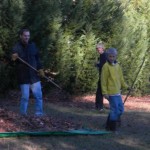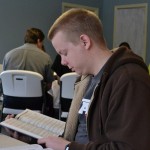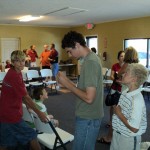When the church becomes visible without signs or marketing
Keith at “subversive1” is writing a series discussing some of the problems (real and perceived) of organic church.
(Now, from the beginning, we must admit that all organic churches are different, so it’s difficult to write this kind of series.)
The latest post is called “Invisible: Organic Church.” This is what Keith says in introducing this weakness:
In our discussion we reflected on the fact that house churches don’t have large signs out front, and don’t market themselves the way traditional churches do. Because of this, it’s often likely that a house church could exist for years right down the street from another house church and not even be aware of each other. Not to mention the fact that people in the community are also not aware that the house church meeting is taking place in their neighborhood.
In the post, Keith offers several suggestions as to how organic or simple churches can become more visible.
We’re found one primary way to let people know that the church is among them: serve people in your community together and introduce them to your brothers and sisters. It’s simple. It’s effective. It gets the focus off of your particular organization (whether that organization is highly organized or not).
When we serve people together, we never say, “Hi, we’re from such-and-such church.” Why? Because the name and location of our meeting is not important.
Instead, we might say something like, “Hi, we’re friends of so-and-so. She/He said you might need some help with your yard work. Can we help you?” At some point, usually when asked or when talking to them later, we’ll explain that we are serving them because God loves them and we love them. We’ll explain that Jesus Christ had welcomed us into his kingdom, and his kingdom was one of loving and serving others.
How do you let people know that the church is in the neighborhood?
When Sunday is just one day out of the week
As I’ve mentioned previously, our church is currently studying Acts together. Last Sunday, we worked our way through most of Acts 2. Next Sunday, we’re planning to finish that chapter.
Of course, Acts 2 includes this amazing summary of the new life that those first believers shared in Christ:
And they devoted themselves to the apostles’ teaching and fellowship, to the breaking of bread and the prayers. And awe came upon every soul, and many wonders and signs were being done through the apostles. And all who believed were together and had all things in common. And they were selling their possessions and belongings and distributing the proceeds to all, as any had need. And day by day, attending the temple together and breaking bread in their homes, they received their food with glad and generous hearts, praising God and having favor with all the people. And the Lord added to their number day by day those who were being saved. (Acts 2:42-47 ESV)
Did you notice that twice Luke writes “day by day”? And, beyond that phrase, notice the number of descriptions that require close and constant interaction: “they devoted themselves” (literally, “they kept on being faithful to…”), “were together,” “had all things in common,” etc.
These early disciples did not see each other on Sunday and then live the rest of the week separated from one another. They were intimately connected with one another’s lives – right away! This does not necessarily mean that they gave up everything else in their lives. It means that they included one another in every aspect of their lives.
It is so much different today. Today, if Christians see each other in the crowd on Sunday, then that’s enough. If we also see each other on Wednesday night, then we call it a close relationship. If we grab a plate and scarf down our food quickly before prayer meeting, then we call it fellowship.
But, in our neighborhoods? In our work places? In our schools? At the park? No. We don’t hang out with one another in those places… only in the church building for church sanctioned programs.
The focus on Sunday (and the church building and the church program and church leadership) is killing the church.
But, when Sunday becomes just another day out of the week, and we learn to actually share our lives with one another throughout the week, wherever we are, and whatever we’re doing, we will see new life – the life of Christ through the Spirit – coursing through the church again. Why? Because when we fellowship (actually fellowship) with one another, we are truly fellowshiping with God the Father and with his Son Jesus Christ. (1 John 1:3)
(No, this post is not about honoring one day above others – which would have been a reference to Saturday, the Sabbath. In the early church, even those believers who honored the Sabbath above other days ALSO shared their lives with one another often during the week, not just on that one day.)
This church is meeting for a real church service
Chris at “The Amplified Life” continues to tell us about their church’s plans to serve their community. The most recent post is called “5th Sunday is Coming.”
I linked to their “5th Sunday” plans a few weeks ago. They are planning to give up their “5th Sunday” church “worship services” in order to serve their community. Yes, I know that some churches are out and about in their neighborhoods serving all the time. But, I’m excited when I read about churches beginning to understand their responsibility to their neighbors.
Here is part of their plans:
So far we have four service areas for the day. First, we will be doing a litter pluck on the stretch of highway in our local community. Second, we will be doing a litter pluck in at a recreational area along the Delaware River (and this 5th Sunday is on Memorial Day weekend…there will be people present in the area–I wonder what God is going to do in that area?). Third, a few miles from our church there is a nursing home that we will visit and spend time with the the residents. I imagine a group of 30-40 people showing up to love on the elderly in the home and I cannot help but get excited! Finally, a smaller group will be be going to the home of a local widow to do some cleaning and yard maintenance.
I’m praying that this opportunity to give up their normal meeting in order to serve others will be the start of missional living for this church! I’m also praying that other churches see and follow their example. Finally, I’m praying that they are able to show their neighbors the love of God and introduce them to the good news of Jesus Christ!
Arthur describes meeting with the church last Sunday
Arthur from “The Voice of One Crying Out in Suburbia” and his family recently moved. They are meeting with different groups of believers, not necessarily to find “their church,” but to meet some of the brothers and sisters who live near them.
His written a few posts about the church meetings that they’ve attended. His latest post is called “Sunday Report.”
I appreciate the description very much! I also enjoyed getting a “behind the scenes” glimpse into how this church makes decisions, decisions that might be impossible (or at least extraordinarily difficult) for most churches.
What do you think of Arthur’s description?
How does our church meet together (Part 2)
Last week, I wrote “How does our church meet together (Part 1).” In that post, I described what happened when our church gathered together on Sunday, April 3, 2011. I also said that our next weekly meeting (April 10, 2011 – 2 days ago), would be somewhat different.
In this post, I’m going to describe how we met together last Sunday. We’ve met like this several times during the last year, and most people seem to enjoy it tremendously.
Again, people begin arriving just before 10:30 a.m. This time, instead of setting up our chairs in two concentric circles, we set up several tables with chairs around each table. Again, people brought food with them as they arrived.
Around 10:30, we all found seats around the table and began singing a few songs. This time, instead of someone choosing songs for us to sing, each person was given an opportunity to suggest a song for us to sing. The person would also explain why he/she wanted to sing that particular song.
After singing a couple of songs, we read through the book of Colossians again. We’ve been reading through and studying the book of Colossians together for several weeks, and this was to be our last week of studying Colossians. Different people read different parts of the book.
Then, we sang another couple of songs, and I led us through a review of what we had studied so far. This review was extremely interactive. Afterward, one our younger brothers – a 13 year old – had prepared a teaching on Colossians 4:7-18, so he led us in studying that passage as part of our ongoing study. As he stepped through the passage, other people also taught/shared from their own studies.
Next, we broke a loaf of bread and passed it around to begin our meal together. As we ate the bread together, several people “remembered” Jesus by sharing about the significance of his broken body. Then we continued the meal by eating lunch together around the tables. As we ate, each table discussed amongst themselves the significance of what we had learned from the letter to the Colossians.
After we had eaten, a few people from each table shared what they had talked about with the whole group. Then we continued encouraging one another as a group. Eventually, again, this resulted in people asking for prayer, and someone praying for them.
After praying for a while, we passed around the juice (no, we don’t use wine). As we filled our cups, different people “remembered” Jesus and the significance of the cup of the new covenant. By this time, it was about 1:30 p.m., and we had been meeting together for about 3 hours.
Even after drinking from the cup together, many people hung out for a long time. Some of us then went to a local park to play volleyball together.
While the “format” of this meeting was different from the one before, the purpose was the same. We met together to help one another grow in maturity in Jesus Christ.
How does our church meet together? (Part 1)
Occasionally, I like to share examples of how we meet together as a church. Why? Because that’s the number one question that I’m asked by people who meet me and find out that our church is a hybrid – somewhere between an organic church and an institutional church. While most of our life together is organic and relational, many aspects of our weekly meeting (not other meetings) are carryovers from our more traditional beginnings.
By the way, this is “Part 1” because next Sunday we will be meeting together in a completely different way. I’ll tell you about that meeting next week in “Part 2.”
We have decided to rent a small store front to meet in on Sundays and for other uses throughout the week, and we have decided to start meeting at 10:30 a.m. on Sundays (except when we go to the beach or park or somewhere else together). So, a little before 10:30 people start arriving. As they arrive, some start setting up chairs, while others chat with one another or pass out hymnals, song sheets, etc. This Sunday, we set the chairs out in two concentric circles.
As people arrive, most of them bring food, because they know that we are planning to eat together. How do they know? Because we do this every week. Sometimes we plan bigger meals (like we did last Sunday), or sometimes people just bring sandwiches, soups, or whatever. Most people bring enough to share so that we can invite others to join us even if they didn’t bring food.
Around 10:30 – the exact time is not as important to us – everyone begins finding a seat, and someone “kicks off” our meeting. Since I was planning to facilitate our teaching last Sunday, I started our meeting off by asking people if they had anything they wanted to share from Colossians. We have been studying Colossians for a few weeks, and several people made very good and challenging observations.
One of our brothers who plays guitar led us in a few songs. There were a couple of hymns and a couple of newer songs. In the middle of singing, we stopped to read through Colossians. We read the entire book, with different people taking turns reading different sections of the book. After reading Colossians, we sang a couple more songs.
We had scheduled to study Colossians 3:5-4:6. So, I started the teaching time by doing a brief review of the first part of Colossians that we had already discussed in previous weeks. Then, another brother taught for a few minutes on the first part of our passage for the week. I continued the teaching, asking for and receiving input from the church. We took the passage paragraph by paragraph, and often returned to previous sections of the book or other parts of Scripture to help us all understand something. (By the way, I was not the only one referring to other parts of Colossians or Scripture.)
Once I had completed what I wanted to teach, the church continued discussing the passage. Many times, people would talk about specific applications to their own lives, or they would make a connection to something that had already been said.
As is usually the case, the discussion of Scripture resulted in people asking the church to pray for them about certain things. We would stop then and pray. We spent alot of time asking for prayer and praying for people.
By this time, it was about 12:30, so we started moving the chairs around and setting up tables. We have several round tables and a few rectangular ones. Once the tables were set up, we broke a loaf of bread and shared the cup (actually several cups). We talked about how Jesus Christ died on the cross for the forgiveness of sins and to invite us into the new covenant with God.
Once we shared the bread and the cup, we continued meeting around the tables while we ate lunch together. This time of food and fellowship and encouragement lasted until about 2:30 or so when people started cleaning up, clearing the room, and heading home.
(By the way, that wasn’t the end of our time together for most of us. Many people continued to spend time with one another during the day. For example, my daughter and I joined other families and friends at a local park for a game of kickball.)
If you have any questions or comments about our meeting, I’ll be more than happy to answer or respond. We’re always open to learning and growing and trying new ways to meet together. Like I said, next Sunday we will meet together in a completely different way. You can read about that meeting next week.
Question about children in the church gathering
Not long after I published my post “Children as Part of the Church Gathering,” I started getting pings (notifications) that people were linking to the post. (Thank you very much, by the way!) I got notifications from Facebook, Twitter, StumbleUpon, and several other services.
Within 30 hours, that post has become the most read post that I’ve written this year. It may reach my top 10 most read posts of all time soon, if people keep reading it. (This is a little strange – and encouraging – because most of my top read posts are about leadership and salaries.)
But, I’m wondering… why are people interested in that post? I have a few ideas, but I’d love to hear from you. If you are a regular reader or if you are a first-time visitor who followed someone’s link to that post about children, would you please share with me why you think people (yourself and/or others) are interested in the topic of including children in the church gathering?
Children as Part of the Church Gathering
A few weeks ago, in my post “Q&A Session,” Randi asked several very good questions. One of the questions involved children, specifically about “incorporating children into the gatherings of the church.” In this post, I’m going to describe some of the ways that we incorporate or include children when the church gathers together.
To begin with, we must understand that (as with adults) there are two types of children: those who are believers and those who are not. We must recognize the difference and know how to encourage each group.
Second, children cannot be treated as second class citizens. No, they are not adults, but they are also not less important than adults. If God has placed children among the church, then he has done so because the church needs them there. They are not distractions.
This leads me to a third point. While children are as important as adults, they are not adults and should not be expected to act like adults. Why would we expect children to sit quietly while the adults interact with one another? (Of course, sometimes, adults can’t sit still either. So, we often stand up, walk around, move from here to there. There’s nothing sacred or reverent about sitting still in one place for an hour or two.)
Finally, while children are as important as adults, they do not have the same experience or ability to process information as adults. We must teach and interact with them on their level as well. (You’ll also find that many adults appreciate and learn from speaking at a “child’s level.”)
Whenever questions are raised about children, it’s usually about how the children can be a distraction to meeting together. The parents or other adults can’t concentrate on what is happening because of the children – noisiness, moving around, etc. This demonstrates that the adults (not the children) do not understand why they are meeting together. They are not there (simply) to concentrate on what is happening or what other people are saying. This is a selfish and self-centered attitude. Instead, we should be focused on others, which includes the children.
Instead of being “distracted” by the children, we should understand that God is giving us opportunities to serve him by caring for and interacting with those children, and perhaps giving the parents a break. Of course, you may not hear what someone else is saying, but that’s not why you’re there, right? You’re there to build up the body of Christ, which includes the children and their parents.
So, what do we do with the children? Well, we include them. They sit with us, talk with us, pray with us, ask questions with us, even offer comments to us. We consider the church a family, so the children are part of that family.
For myself, as I am teaching, I try to ask questions specifically to the younger children. As I begin teaching Colossians, I plan to talk to the children about sending letters, how they like to receive letters, and if they’ve sent letters.
The older children and teenagers taken an even more active part in the our church gatherings. They will usually read Scripture and even take part in the teaching. (Of course, the younger children are also encouraged to take part, and often do.) We specifically try to encourage the teenagers to begin preparing to meet with others believers.
Children (old and young) have prayed for us and asked for prayer; they have taught us, and they have learned. Children have suggested service projects, and they have taken part while we serve others. Some of our children have even started projects to serve other on their own. The younger children often sit in the floor and color or play when we meet. I love it when an adult (who is not the child’s parent) joins the child in the floor.
Recently, while we were gathered together, a young couple with their toddler daughter was meeting with us. The daughter was sitting in a walker. Suddenly, while we were discussing a certain passage of Scripture, she sped across the floor in her walker. We all laughed and rejoiced seeing her having fun and growing and learning to walk. This is just as much as part of church life (and just as important) as anything else.
Let’s include the children as part of the church, encourage them to allow God to work through them, and ask God how he wants us to serve the children while we are meeting.
The Didache: Gather together frequently
I have been progressing slowly (very slowly) on my dissertation. (In case you forgot, my dissertation is titled “Mutual Edification as the Purpose of the Assembled Church in the New Testament: A Study in Biblical Theology.”) Currently, I’m studying what various Christians wrote about the assembled church in different time periods of church history.
Lately, I’ve been studying the Didache. The first part of the Didache (chapters 1-6) deals with the “two ways”: the way of life and the way of death. Many of the exhortations echo what we read in Scripture.
The last part deals with various practical (as if the way of life is not practical) aspects of living together as the church. The author discusses baptism, fasting, the Lord’s Supper / Eucharist (which those eating leave “filled”), various traveling servants (apostles, prophets, teachers), local servants, and choosing elders and deacons.
The conclusion of this book begins with an exhortation to “be on the alert”! What does he want them alert about? Well, several things, but gathering together is one of those things. Here is that passage:
Now, gather together frequently seeking those things which are fitting for your lives. For the whole time of your faith will not benefit you if you are not made mature by the last time. (Didache 16:2 author’s translation)
The author of the Didache tells his readers to gather together for one purpose: to seek those things which are fitting (proper) for your lives (souls). (Interestingly, worship is not mentioned in this passage.) What are the things that are fitting for their lives?
He says that the entire time of their faith (the entire time of living by faith?) will only benefit them if they mature by the end of their lives. Thus, he wants them to mature; he expects them to mature. In fact, the language is quite shocking. If they do not mature (in the context of their meeting together), then their entire time of faith will be of no benefit.
This sounds very similar to Hebrews 10:24-25:
And let us consider how to stir up one another to love and good works, not neglecting to meet together, as is the habit of some, but encouraging one another, and all the more as you see the Day drawing near. (Hebrews 10:24-25 ESV)
The Epistle of Barnabas (another early Christian writing) also has a similar passage:
For this reason, we should be attentive in these last days; for the whole past time of your life and faith will be of no benefit to us, unless now in this wicked time we should stand against coming temptation, as is suitable for children of God. Therefore, in order that the Black One may find no means of entrance, we should flee from every futility (frustration?), and we should completely hate the works of the way of evil. Do not live separate lives, by each going his own way, as those who have already been justified; but by coming together in harmony, you must discuss what leads to the benefit of all. (Barnabas 4:9b-10)
In the Didache passage, notice the words the author uses to describe the expected gathering: “frequently” and “fitting for your lives.” Also, notice the verbs used to describe the gathering: “benefit” and “made mature.”
Similar phrases are found in the Hebrews passage: “not neglecting,” “love and good works,” and “encouraging.” And, similarly, we find these in the passage from the Epistle of Barnabas: “benefit,” “stand against temptation,” “suitable,” and “harmony.”
While there are some differences in this descriptive terms (some positive, some negative, for instance), they are very similar. And, the instructions were given to all the readers, not just the leaders. (That’s true of Hebrews, the Didache, and Barnabas – all written to and addressed to all believers, not just to overseers, elders, deacons, teachers, prophets, apostles, etc.)
Should we still expect these same types of phrases to describe our gatherings? Is it still the responsibility of all the believers, or just the leaders?
Distracted by location or setting
Arthur at “The Voice of One Crying Out in Suburbia” is “Speaking of Church on Tuesday.”
He and his family gathered together with some other believers (from several different churches) on a Tuesday evening. And, they gathered together in a barn behind someone’s house.
While his description of their meeting is very interesting, I was most encouraged by his final paragraph:
For many Christians. the location and setting of this meeting would have been disconcerting. It was at someone’s home, it was in the evening and it wasn’t really “churchy”. Even though we devoted ourselves to the same things the earliest church did (fellowship, breaking bread, prayers, teaching, i.e. Acts 2:42), it would seem strange, perhaps even uncomfortable. It is a grave concern of mine that so many of us are conditioned to a rigid view of not just how the church can meet but how the church must meet. We miss so many opportunities to be encouraged and edified by trying to box in the church.
This is a very good – and very true – observation.When we feel that the church is only the church when they are meeting at certain times or certain locations, then I think we misunderstand what it means to be the church.
What do you think?










